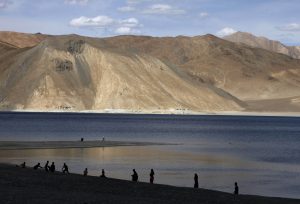On Tuesday, the armed forces of India and China began to partially disengage along the Line of Actual Control in Eastern Ladakh, where the two sides have been mired for weeks in standoffs along separate points.
Although the steps Tuesday were not officially and publicly announced, Indian sources who spoke to the Hindu noted that the following steps had been taken by the two sides: “Partial deinduction has happened from some points in Galwan and Hot Springs areas. [The] Chinese side removed some of the tents and some troops and vehicles have been moved back, and the Indian side too has reciprocated.”
“At some points in the Galwan Valley, Chinese troops have moved back 2-3 km,” the Hindu reported. One of the major flashpoints between the two sides, at Pangong Lake, which is bisected by the Line of Actual Control, continues to be unresolved, per the reports.
According to Indian news agency ANI, the disengagement also resulted in the movement of Chinese “troops and infantry combat vehicles,” which “moved back by 2.5 km” in the Galwan area. “India has also moved some of its troops back,” ANI reported, citing Indian government sources.
This week’s disengagement, however, would suggest that the ongoing talks between the two sides are creating some momentum toward deescalation. India and China have been using a variety of diplomatic and military mechanisms to communicate over their ongoing standoff, which is the most serious between them in years.
On Saturday, the Indian and Chinese sides met at the corps commander level through military channels in the Chushul-Moldo region of Ladakh and “agreed to peacefully resolve the situation in the border areas in accordance with various bilateral agreements,” the Indian Ministry of External Affairs said in a statement.
That statement noted that the two sides would “continue the military and diplomatic engagements to resolve the situation and to ensure peace and tranquility in the border areas.” Meetings at lower military levels had taken place intermittently after the initial clashes in Ladakh in early May.
According to one Indian report, high-level Indo-Chinese communication has also taken place. Nitin Gokhale, of Bharat Shakti, an Indian publication, reported that Indian National Security Advisor Ajit Doval spoke with Yang Jiechi, director of the Central Foreign Affairs Commission of the Central Committee of the Chinese Communist Party, on May 8.
India is one of two countries with China continues to have an unsettled land border (the other being Bhutan). Much of the border remains undefined, undelineated, and undemarcated.
With the exception of a May 9 incident at Naku La, along the settled Sino-Indian border off the northern border of the Indian state of Sikkim, other major standoffs have taken place in the unsettled western sector of the disputed border, which separates Indian-administered Kashmir from Chinese-held Aksai Chin.
Over the course of the standoff, both India and China have accused the other of sending troops onto the other’s territory across the Line of Actual Control.

































